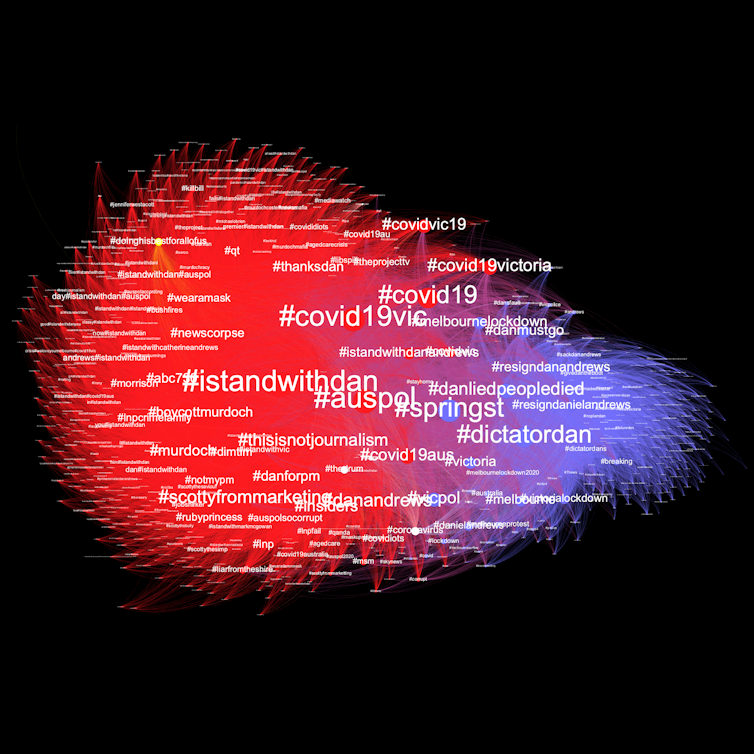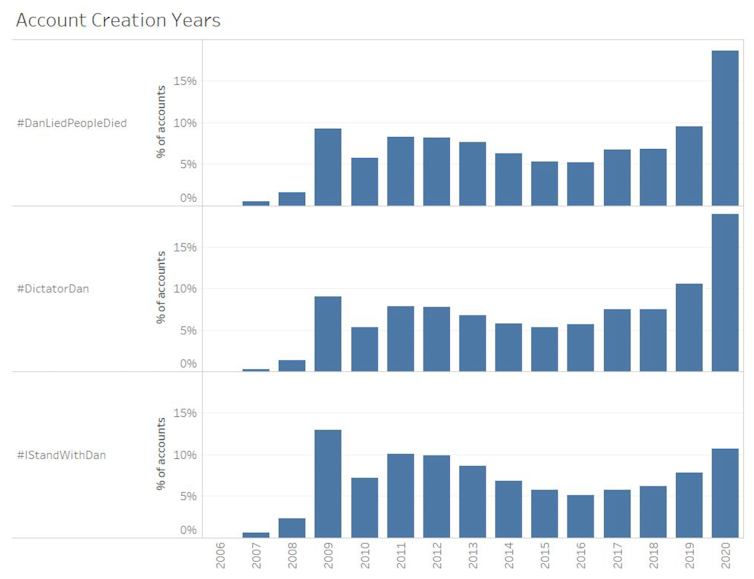#IStandWithDan, #DictatorDan, #DanLiedPeopleDied: 397,000 tweets reveal the culprits behind a dangerously polarised debate
- Written by Timothy Graham, Senior Lecturer, Queensland University of Technology
The Victorian government’s handling of the state’s second coronavirus wave attracted massive Twitter attention, both in support of and against the state’s premier Daniel Andrews.
Our research, published in the journal Media International Australia reveals much of this attention was driven by a small, hyper-partisan core of highly active participants.
We found a high proportion of active campaigners were anonymous “sockpuppet” accounts — created by people using fake profiles for the sole purpose of magnifying their view.
What’s more, very little activity came from computer-controlled “bot” accounts. But where it did, it was more common from the side campaigning against Andrews.
A larger concern which emerged was the feedback cycle between anti-Andrews campaigners (both genuine and inauthentic), political stakeholders and partisan mainstream media which flung dangerous, fringe ideas into the spotlight.
A few highly-charged accounts driving debate
In mid-to-late 2020, thousands of Australian Twitter users split themselves into two camps: those who supported Andrews’ handling of the second wave and those who didn’t.
We looked at 397,000 tweets from 40,000 Twitter accounts engaging in content with three hashtags: #IStandWithDan, #DictatorDan and #DanLiedPeopleDied.
Our comprehensive analysis revealed pro-Dan activity greatly outnumbered the dissent. #IStandWithDan featured in 275,000 tweets. This was about 2.5 times more than #DictatorDan and 13 times more than #DanLiedPeopleDied.
 This hashtag network shows the polarised Twitter discussions in support of (red) and against (blue) Victorian Premier Daniel Andrews.
This hashtag network shows the polarised Twitter discussions in support of (red) and against (blue) Victorian Premier Daniel Andrews.
Activity on both sides was mostly driven by a small but highly-active subset of participants.
The top 10% of accounts posting #IStandWithDan were behind 74% of the total number of these tweets. This figure was similar for the top 10% of accounts posting anti-Andrews hashtags — and the same pattern applied to retweet behaviour.
Our findings challenge the idea of Twitter as the true voice of the public. Rather, what we saw was a small number of pro- and anti-government campaigners that could mobilise particular Twitter communities on an ad hoc basis.
This suggests it only takes a small (but concentrated) effort to get a political hashtag trending in Australia.
Read more: The story of #DanLiedPeopleDied: how a hashtag reveals Australia's 'information disorder' problem
Who started the campaigns?
Our analysis showed Liberal state MP Tim Smith was instrumental in making the #DictatorDan hashtag go viral.
It was in low circulation until May 17, when Smith created a Twitter poll asking whether Andrews should be labelled “Dictator Dan” or “Chairman Dan”.
Subsequent growth of #DictatorDan activity was driven largely by far-right commentator Avi Yemini and his followers, along with a key group for fringe right-wing politics in Australian Twitter.
Meanwhile, #DanLiedPeopleDied went viral later on August 12, sparked by another right-wing group led by a handful of outspoken members. This group managed to get the hashtag trending nationally.
This attracted Yemini’s attention. The same day the hashtag started trending, he posted seven tweets and seven retweets with it to his then 128,000 followers. A considerable increase in activity ensued.
The hashtag #IStandWithDan had little activity until July 8, when it suddenly went viral with nearly 1,600 tweets. This spike coincided with the announcement of stage 3’s “stay at home” restrictions for metropolitan Melbourne and the Mitchell Shire.
Activity surrounding #IStandWithDan was driven by factors including the various stages of lockdown, attacks on Andrews from conservative media and the emergence of anti-Andrews Twitter campaigners.
Tweeting (loudly) from the shadows
We analysed the top 50 most active accounts tweeting each hashtag, to figure out how many of them didn’t belong to who they claimed and were in fact anonymous sockpuppet accounts.
We found 54% of the top 50 accounts posting anti-Andrews hashtags qualified as sockpuppets. This figure was 34% for accounts posting #IStandWithDan.
The onslaught from anonymously-run accounts on both sides had a massive impact. Just 27 sockpuppet accounts were behind 9% of all #DictatorDan tweets and 14% of all #DanLiedPeopleDied tweets.
Similarly, 17 accounts were responsible for 6% of all #IStandWithDan tweets.
Inauthentic activity
Many of the anti-Andrews accounts were created more recently than those posting pro-Andrews hashtags. The imbalance between new accounts posting pro- and anti-Andrews hashtags probably isn’t by chance.
 This graph shows the distribution of when accounts from both sides were created. From the accounts pushing the #DictatorDan tag, 19% were created this year — compared to 10.7% of accounts posting #IStandWithDan.
This graph shows the distribution of when accounts from both sides were created. From the accounts pushing the #DictatorDan tag, 19% were created this year — compared to 10.7% of accounts posting #IStandWithDan.
It’s more likely anti-Andrews activists deliberately created sockpuppets accounts to give the impression of greater support for their agenda than actually exists among the public.
The aim would be to use these fake accounts to fool Twitter’s algorithms into giving certain hashtags greater visibility.
Interestingly, despite accusations of bot activity from both sides, our work revealed bots actually accounted for a negligible amount of overall hashtag activity.
Of the top 1,000 accounts most frequently tweeting each hashtag, there were just 50 anti-Andrews bot accounts (which sent 264 tweets) and 11 pro-Dan accounts that posted #IStandWithDan (which sent 44 tweets).
Polarisation creates a feedback loop with media
Some of the ways news media engaged with (and amplified) the debate around Victoria’s lockdown helped stoke further division. On September 17, Sky News published the headline:
‘Dictator Dan’ is trying to build a ‘COVID Gulag’.
Herald Sun columnist Andrew Bolt repeated the “Dictator Dan” label in both his blogs and widely read opinion columns, which were part of a much-criticised series attacking the premier.
Here, we witnessed the continuing problem of the “oxygen of amplification”, whereby news commentators amplify false, misleading and/or problematic content (intentionally or unintentionally) and thereby aid its creators.
The #DictatorDan hashtag was used to cast doubt on Andrews’ lockdown measures and establish a false equivalence between the two rivalling Twitter communities, despite Andrews’ having strong approval ratings throughout the pandemic.
The “debate” surrounding the premier’s lockdown measures even gained international attention in a Washington Post article, which Sky News used in a bid to legitimatise its “Dictator Dan” narrative. Yet, at the end Victoria emerged as the gold standard for second-wave coronavirus responses.
Read more: Finally at zero new cases, Victoria is on top of the world after unprecedented lockdown effort
A polarised Twittersphere might be entertaining at times, but it sustains a vicious feedback loop between users and partisan media. Irresponsible news commentary provides fuel for Twitter users. This leads to more polarity, which leads to more media attention.
Those with a voice in the public sphere should ask critical moral questions about when (and whether) they engage with hyper-partisan content. In the case of COVID-19, it can carry life and death consequences.
Authors: Timothy Graham, Senior Lecturer, Queensland University of Technology





